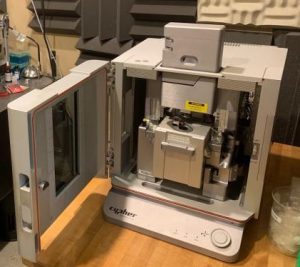
Scientists at the University of Missouri (MU), who report that they used a new approach to discover how proteins leave the inside of an E. coli cell, say their finding could have important implications for how we treat diseases based on these movements. They published their study (“Direct visualization of the E. coli Sec translocase engaging precursor proteins in lipid bilayers“) in Science Advances.

“Escherichia coli exports proteins via a translocase comprising SecA and the translocon, SecYEG. Structural changes of active translocases underlie general secretory system function, yet directly visualizing dynamics has been challenging. We imaged active translocases in lipid bilayers as a function of precursor protein species, nucleotide species, and stage of translocation using atomic force microscopy (AFM). Starting from nearly identical initial states, SecA more readily dissociated from SecYEG when engaged with the precursor of outer membrane protein A as compared to the precursor of galactose-binding protein,” the investigators wrote.
“For the SecA that remained bound to the translocon, the quaternary structure varied with nucleotide, populating SecA2 primarily with adenosine diphosphate (ADP) and adenosine triphosphate, and the SecA monomer with the transition state analog ADP-AlF3. Conformations of translocases exhibited precursor-dependent differences on the AFM imaging time scale. The data, acquired under near-native conditions, suggest that the translocation process varies with precursor species.”
“Proteins are like vehicles that can carry information and materials in cells,” said Gavin King, PhD, an associate professor of physics in the MU College of Arts and Science and joint associate professor of biochemistry. “We focused on the cells of E.coli, which have two membranes. We observed that when proteins exit the cell’s inner membrane, the cell adjusts the way it transfers the protein through the channel depending on the type of protein being transported.”
King worked with Linda Randall, PhD, professor emerita of biochemistry. Randall verified the transportation function of E. coli cells outside of their natural environment. Once verified, the samples were sent to King where King’s team used an atomic force microscope to study the movement of the E. coli proteins. Unlike previous studies where proteins were frozen, the atomic force microscope allows researchers to observe the proteins moving in a fluid environment that closely resembles their natural environment.
“Before our study there were two ways of describing how proteins moved across the cell membrane—either a piston-live movement similar to a car’s engine, or a more perpetual motion known as the Brownian ratchet,” King said. “Neither model accounted for the differences based on the type of protein being transported. Just as different types of vehicles move differently so do different types of proteins. The maps we made to depict the proteins’ movement suggest nature might be more complex than previously thought.”
These findings provide basic knowledge on how a cell sends and receives material and information, noted the researchers. For instance, a drug can pass through membranes in order to affect a cell, and similarly, some information must pass through membrane channels to exit the cell. While other cells besides E. coli may not have E. coli’s exact protein transportation system, King said, a similar system exists in all cells.


